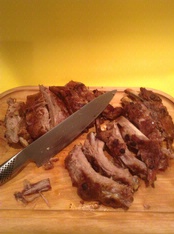WINE WITH…Oven-Roasted Asian Pork Ribs
Ideally, the deliciously spicy ribs for this dish will rest in the

refrigerator overnight, soaking up the marinade’s delicious Asian flavors. Then the next day they get roasted slowly in the oven until they are falling-off-the bone tender and luscious. With almost all the prep work having been done the day ahead, all you have to do at the last minute is cook some rice and prepare coleslaw or perhaps some green beans to serve alongside them.
Oven-Roasted Asian Pork Ribs
1/3 cup minced onion
2 tablespoon minced or grated fresh ginger
2 tablespoons soy sauce
1 tablespoon fish sauce
1 tablespoon hot chili paste (we used Lan Chi brand)
2-3 cloves finely minced garlic
2 tablespoons brown sugar
1 teaspoon salt
3-4 pounds pork spare ribs
garnish: minced scallions, mint and/or cilantro
Place the minced onion in a large bowl along with the ginger, soy sauce, fish sauce, chili paste, garlic, brown sugar and salt. Combine the ingredients thoroughly, and then put the ribs in the bowl (cut the rack in half to make it fit if necessary). Coat the meat with the mixture; then cover the bowl and marinate the ribs in the refrigerator for at least a couple of hours and preferably overnight.
To cook the ribs, preheat the oven to 425°
Place the ribs in a roasting pan and pour in 2 cups water. Cover the pan with foil and cook for 30 minutes. Lower the heat to 350° and roast for another 60 minutes. The meat should be very tender at this point. Remove the foil and continue cooking for about 15 minutes, or until the meat is nicely browned and almost falling off the bones.
Remove the ribs to a cutting board and pour the cooking juices into a small pan. Skim the fat off the top; then reduce the sauce for about 5 minutes until it has thickened somewhat. Divide the ribs with a sharp knife, arrange them on a platter, and pour the sauce over them. Top with the garnish and serve at once.
* * *
This turns out to be a very versatile dish when it comes to wine pairing. Whites work well, as they complement the sweet and spicy sauce. At the same time, reds pair nicely with the ribs themselves. Not every wine we tried, however, made for a winning combination. A German Riesling, though labeled “trocken,” proved too juicy and sugary, while a Cabernet offered too much tannin. Look for wines, no matter their color, that will contribute to but not dominate the match. The dish itself is filled with all sorts of intriguing flavors. Simple refreshment, not added complexity, is what you’ll want from the wine.